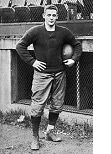 9-0
9-0 
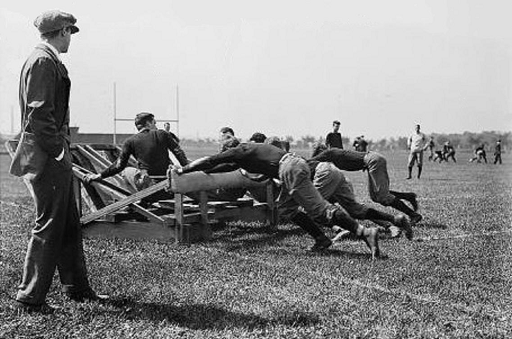
| Bates (5-1-3) | 22-0 | |
| Bowdoin (6-1-2) | 32-0 | |
| Williams | 21-0 | |
| Amherst | 17-0 | |
| Brown (7-2-1) | 12-0 | #5 |
| at Army (6-2) | 6-0 | #7 |
| Cornell (5-2-1) | 27-5 | (#26-39) |
| Dartmouth (5-2) | 18-0 | #15 |
| at Yale (6-2-2) | 0-0 | #8 |
 9-0 Pittsburgh
won every game by more than a touchdown, and also shut out every
opponent (total score 282-0), which is likely why the National
Championship Foundation selected them to share the MNC with Harvard.
The coach was Joe Thompson, the star Hall of Fame
halfback of their 10-0 1904 team. He went 30-14-2 as coach at Pitt 1908-1912.
9-0 Pittsburgh
won every game by more than a touchdown, and also shut out every
opponent (total score 282-0), which is likely why the National
Championship Foundation selected them to share the MNC with Harvard.
The coach was Joe Thompson, the star Hall of Fame
halfback of their 10-0 1904 team. He went 30-14-2 as coach at Pitt 1908-1912.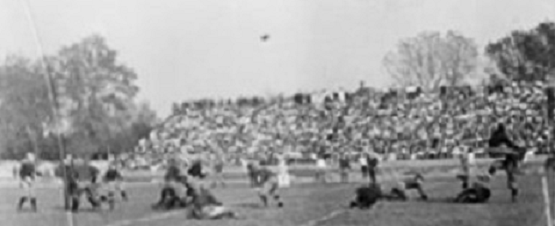
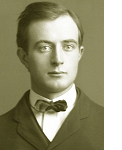 As usual, 8-0-1 Vanderbilt ruled the South in 1910,
led by Hall of Fame coach Dan McGugin (pictured at left) and
All-Southern
quarterback Ray Morrison, who went on to become a Hall of Fame coach
himself (at 4 schools, most notably at Southern Methodist 1915-'16
& 1922-'34). Team captain Bill Neely, an end and halfback, was
All-Southern, and his brother Jess would one day become a Hall of Fame
coach as well. Tackle Ewing Freeland was All-Southern for 3 seasons,
and he became a coach at TCU and SMU, but not a Hall of Famer. Guard
William "Frog" Metzger was a unanimous All-Southern selection, and he
also made Walter Camp's 3rd team All American list.
As usual, 8-0-1 Vanderbilt ruled the South in 1910,
led by Hall of Fame coach Dan McGugin (pictured at left) and
All-Southern
quarterback Ray Morrison, who went on to become a Hall of Fame coach
himself (at 4 schools, most notably at Southern Methodist 1915-'16
& 1922-'34). Team captain Bill Neely, an end and halfback, was
All-Southern, and his brother Jess would one day become a Hall of Fame
coach as well. Tackle Ewing Freeland was All-Southern for 3 seasons,
and he became a coach at TCU and SMU, but not a Hall of Famer. Guard
William "Frog" Metzger was a unanimous All-Southern selection, and he
also made Walter Camp's 3rd team All American list.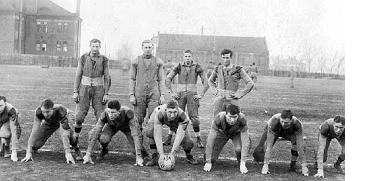 6-0 Colorado
(pictured at left) was led by Hall of Fame coach Fred Folsom, for whom
Colorado's stadium
is still named. He won 10 conference titles in 15 years at Colorado,
going 77-23-2 there, and 106-28-6 overall with a 29-5-4 mark in 4 years
coaching his alma mater, Dartmouth. That record places him on the list for all-time FBS coaching
win percentage. 1910 is the second of three straight seasons that
Colorado went unbeaten and untied.
6-0 Colorado
(pictured at left) was led by Hall of Fame coach Fred Folsom, for whom
Colorado's stadium
is still named. He won 10 conference titles in 15 years at Colorado,
going 77-23-2 there, and 106-28-6 overall with a 29-5-4 mark in 4 years
coaching his alma mater, Dartmouth. That record places him on the list for all-time FBS coaching
win percentage. 1910 is the second of three straight seasons that
Colorado went unbeaten and untied.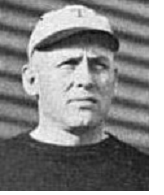 Colorado College did something Colorado did not in
1910-- they beat a strong Missouri Valley team, topping 10-1 Kansas
State 15-8. KSU dealt 7-1 Arkansas their only loss, who dealt 8-1 Texas
A&M their only loss. Colorado College thus sits atop a totem pole
of pretty good teams, and given that Colorado outperformed Colorado
College against 4 common opponents, we can safely assume that Colorado
was at least as strong, if not stronger.
Colorado College did something Colorado did not in
1910-- they beat a strong Missouri Valley team, topping 10-1 Kansas
State 15-8. KSU dealt 7-1 Arkansas their only loss, who dealt 8-1 Texas
A&M their only loss. Colorado College thus sits atop a totem pole
of pretty good teams, and given that Colorado outperformed Colorado
College against 4 common opponents, we can safely assume that Colorado
was at least as strong, if not stronger.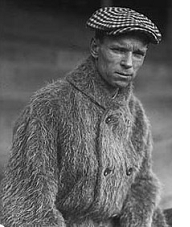 6-0 Washington was a lot like 6-0 Colorado:
they played no one outside their region, they were led by a Hall of
Fame coach, and they were in the middle of a streak of unbeaten and
untied seasons. However, both their coach and their winning streak were
much more impressive than Colorado's. The coach was Gil Dobie
(pictured at left), who went 58-0-3 at Washington 1908-1916-- you read
that right, they did not lose a game in those 9 years.
6-0 Washington was a lot like 6-0 Colorado:
they played no one outside their region, they were led by a Hall of
Fame coach, and they were in the middle of a streak of unbeaten and
untied seasons. However, both their coach and their winning streak were
much more impressive than Colorado's. The coach was Gil Dobie
(pictured at left), who went 58-0-3 at Washington 1908-1916-- you read
that right, they did not lose a game in those 9 years.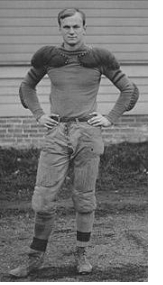 In
1910, Washington was led by quarterback Wee Coyle, who was 26-0-1 at
Washington, and by end Warren "Wedge" Grimm (pictured at left), the team captain and a 3rd
team All American selection by Walter Camp. Washington dominated most
of the teams on their schedule,
outscoring opponents 150-8, but they struggled to beat the only team
that scored on them, Whitman, 12-8. Whitman's scores were set up by a
pair of Washington fumbles early in the game.
In
1910, Washington was led by quarterback Wee Coyle, who was 26-0-1 at
Washington, and by end Warren "Wedge" Grimm (pictured at left), the team captain and a 3rd
team All American selection by Walter Camp. Washington dominated most
of the teams on their schedule,
outscoring opponents 150-8, but they struggled to beat the only team
that scored on them, Whitman, 12-8. Whitman's scores were set up by a
pair of Washington fumbles early in the game.| 1) Billingsley (math system) | 4.5 |
| 2) Houlgate (math) | 4.39 |
| 3) Parke Davis | 4.36 |
| 4) Helms | 4.2 |
| 5) National Championship Foundation | 3.2 |